
Celebrate ten years of Urban Omnibus and support ten more years of fresh, independent perspectives on citymaking with a donation today!
Celebrate ten years of Urban Omnibus and support ten more years of fresh, independent perspectives on citymaking with a donation today!
The renaissance of New York City’s park system over the past fifteen years has coincided with a return of megaprojects in real estate. The big vision, and big investments, in free space and public recreation — like the High Line or Brooklyn Bridge Park — aren’t often thought to correspond to the commensurate development of private property and commercial recreation — from Hudson Yards to Atlantic Yards to Willets Point. Yet in the opinion piece below, Samuel Stein, a community organizer and Elmhurst resident, grounds his impassioned argument against a proposed Major League Soccer Stadium in Flushing Meadows Corona Park in the complex historical relationship between parks and grands projets in New York City. While his position on this project is personal, the history he unearths — of the Queens’ park’s evolution from an ash dump to the celebrated grounds of two World’s Fairs to the biggest public park in the city’s most diverse borough, already home to two large sporting complexes — is of interest to anyone interested in the fine and eroding line between public and private interests in the city’s precious remaining open space. –C.S.
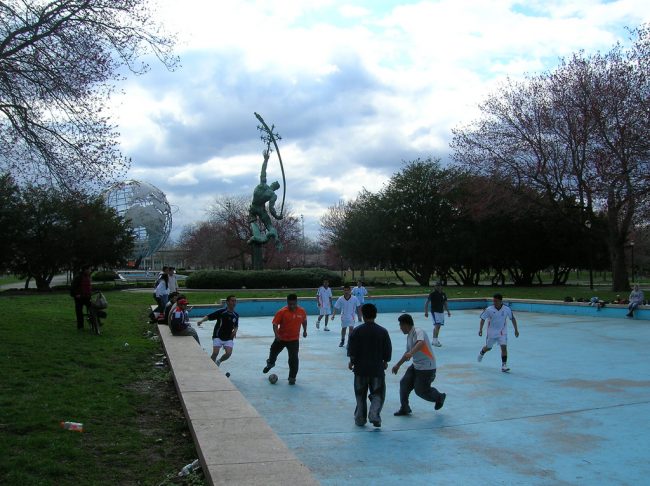
Photo by Larry Rowe
“The community embraces soccer, and soccer is the lifeblood of the community.” That’s what Brett Lashbrook, a special assistant to the commissioner of Major League Soccer (MLS), told NPR sports correspondent Mike Pesca last December. Describing the borough’s primary park, Flushing Meadows Corona Park, Lashbrook praised “the diversity of Queens and the amount of soccer that’s played in the park currently. Those of you familiar with the park know that it’s not an exaggeration to say that soccer is played in the park 24/7”[1].
He’s right: the Flushing Meadows soccer fields are full nearly every day. It is one of the only large swathes of open space in the city’s largest and most diverse borough. Major League Soccer has its sights set on Flushing Meadows Corona Park and is trying to sell the city on a grand new plan: replacing an existing community of soccer players with a professional soccer stadium, and turning the multi-ethnic soccer fields of central Queens into a ticketed spectacle.
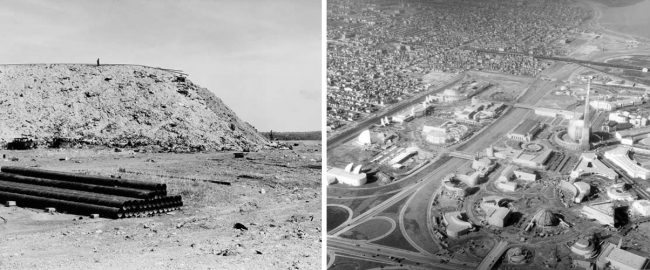
Left: 1934 Image of Flushing Meadows-Corona Park in its early form – an ash dump | Right: Grand Central Parkway, Horace Harding Blvd., World’s Fair construction, November 8, 1938 | Images via New York City Parks Photo Archive
“Beauty for ashes”
At 1,255 acres, Flushing Meadows Corona Park is New York City’s third largest public open space (after Pelham Bay Park in the Bronx and Staten Island’s Greenbelt). The narrow but expansive park touches several central Queens neighborhoods, including Corona, Flushing, Forest Hills, Kew Gardens, Jackson Heights, and Elmhurst, where I live. These are some of the most dense, diverse, and dynamic neighborhoods in the city. Flushing Meadows Corona Park is our only major open space, and even though the park is bounded by highways, overpasses, and cloverleaf interchanges, it is actively used by thousands of people. Aside from the occasional playground, these central Queens neighborhoods contain little space for non-commercial recreation. Many Queens neighborhoods, including Jackson Heights’ leafy historic district, Sunnyside Gardens, and Forest Hills Gardens, were designed as “garden cities” with interior courtyards. As a result, very little land was set aside for easily accessible public parks.
Flushing Meadows was created by master builder Robert Moses during his more generous pre-war period. The park was designed on the site of an industrial wasteland that F. Scott Fitzgerald famously referred to in The Great Gatsby as “a valley of ashes.” One of its most famous features was “Mount Corona,” an industrial ash heap nearly 100 feet tall. For urbanist Marshall Berman, whose family was evicted to make way for Moses’ Cross Bronx Expressway, the development of Flushing Meadows represented a high point in modernist achievement, a period characterized by “beauty of design and human sensitivity” that “turn[ed] sour in the process of their realization,” that “move[d] from the destruction of a Valley of Ashes in 1939 to the development of a far more dreadful and intractable modern wasteland a generation later only a few miles away” [2]. As only Robert Moses could, the famous power broker leveraged the opportunity created by the 1939 World’s Fair to secure millions of dollars from federal, state, and city sources to develop the park. In creating a monumental park out of the Corona Ash Dumps, Moses likened himself to the prophet Isaiah in his quest to “Give unto them beauty for ashes” [3].
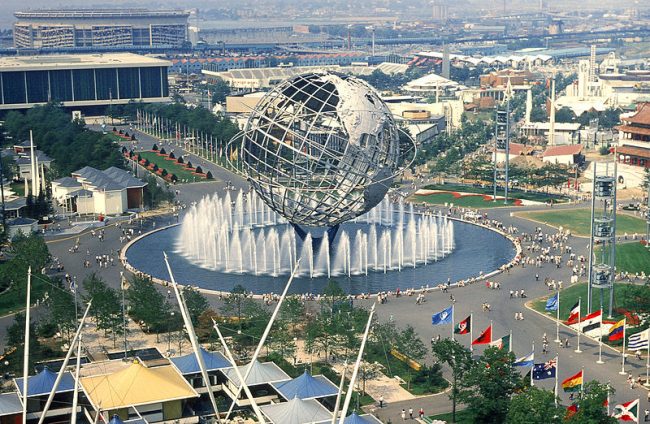
New York World’s Fair 1964-1965 | Image via PLCjr
Flushing Meadows has always lived in the shadows of its sports complexes. Moses hoped to move the Brooklyn Dodgers to his new park, but when negotiations soured between Moses and Dodgers owner Walter O’Malley, the team moved to Los Angeles [4]. Instead the park became home to the city’s newest franchise, the Mets. Flushing Meadows also contained the Singer Bowl, a stadium used for Olympic trials, boxing matches and other periodic sports events, which in 1978 became home to the US Tennis Association. The Singer Bowl was transformed into Louis Armstrong Stadium, which was in turn dwarfed by the USTA’s massive Arthur Ashe Stadium in 1997. In 2009, Shea Stadium gave way to Citi Field, a new home for the Mets built next door to the now-demolished Shea, featuring higher ticket prices and more luxury boxes.
The park’s history reads like Genesis for jocks: “And Singer begat Louis Armstrong, which begat Arthur Ashe…” This is in part because of the way Robert Moses wrote the law that lead to Shea Stadium. As was his wont, Moses drafted this statute to confer unusually broad powers to the Parks Commissioner and the Board of Estimates over the use of park land for stadiums. The law allowed the Parks Commissioner (Moses) to sign contracts with private entities for use of public park space. Some of these agreements would be reviewed by the Board of Estimates, another institution over which Moses held influence [5]. The text of the law allowed park space to be developed for uses as general as “recreation, entertainment, amusement, education, enlightenment, cultural development or betterment, and improvement of trade and commerce, including professional, amateur or scholastic sports and athletic events … and/or any business or commercial purpose that aids in the financing of the construction and operation of such stadium, grounds, parking areas and facilities.” This legal leeway helped pave the way for more and more stadiums and stadium expansions. Now that the Board of Estimates is a thing of the past (it was dismantled by the courts in 1989), the Bloomberg administration argues that the power of site approval for park construction under the 1961 statute should belong solely with the mayor [5].
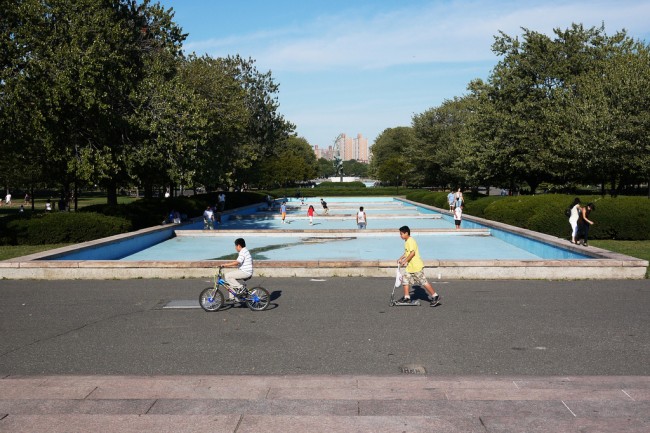
Photo by Matt Johnson
The Plan
Major League Soccer is currently in the process of courting the city and state with vague proposals for their new stadium. Their initial plan calls for a 25,000-seat arena sited over Industry Pond, a water feature surrounded by the park’s famous soccer grounds. The stadium would likely cover seven out of the park’s nine soccer fields, with the remaining two fields separated from the rest of the park by the ominous Van Wyck Expressway. Just like the developers of the new Yankee Stadium, who pledged to build new public spaces after siting the stadium on top of an existing park, MLS promises that it will create new park ground to replace whatever it destroys [6]. (The parks created on the old Yankees Stadium took over three years to open, and cost the city $195.6 million, making them one of the most expensive park development projects in New York history.) MLS has not yet announced where this replacement parkland would come from, and there are no obvious candidates for sites. The proposed soccer stadium would host fewer than 20 matches a year.
The stadium developers sell the project as entirely privately financed, yet opening up scarce public parkland to private development calls this claim into question. MLS promises that construction will create 2,300 union jobs, plus 160 full-time and 750 part-time jobs once the stadium is erected; the experience of Atlantic Yards suggests the jobs numbers could be much lower in practice than in promise. MLS has hired SHoP, the Manhattan architecture firm who reworked the Barclays Center design, to design the Queens soccer stadium. Scoping has just begun for the project’s Environmental Impact Statement, and a vote by the state legislature on converting parkland from public to private use is expected to take place in the spring of 2013 [7].
Major League Soccer’s preferred site for the stadium was Pier 40 in the West Village; the well-organized and generously resourced West Side, however, was able to put a stop to the project long before the proposal took hold. There were many concerns, ranging from fears of clogged streets to questions about the pier’s structural integrity. Neighborhood residents, community board members, and Assemblymember Deborah Glick also pointed to the fact that the pier (like Flushing Meadows) is currently home to a number of ball fields used regularly for amateur soccer games. They questioned MLS’ promises to build other public soccer fields, and worried that the stadium’s footprint would end up much larger than the one proposed. The community had a trump card against the stadium developers in the form of the Hudson River Park Trust, which controls the pier. The legislation that formed the Trust was written in 1998, long after the days of Robert Moses, and contains many more restrictions on what can be built on public land [8].
After failing in Manhattan, MLS’ gaze moved quickly to Flushing Meadows, home not just to two professional sports arenas (baseball and tennis), but also to several other major development proposals backed by the Bloomberg administration. Some of these plans came out of his proposal for a 2012 New York City Olympics; the bid fell through, with London hosting last year’s Olympic games, but many of the development schemes live on. The tennis courts, already a massive “Tennis Center” with two stadiums, are set to expand once again, adding more cars, parking, and paved roads to a park already crisscrossed by highways. Willets Point, a neighborhood of over 250 local businesses specializing in auto repair located directly adjacent to the park, is set to be urban renewaled into oblivion. The New York City Economic Development Corporation (EDC) is sponsoring a plan to remove the industrial area using eminent domain. The businesses are set to be evicted within weeks, to be replaced with a “mixed-use development,” largely consisting of a mall and hotel complex that would spill over into current park land [9]. The city initially promised affordable housing on the site, but housing construction has been pushed back until 2025.
If all these projects manifest, the open space at the heart of Flushing Meadows could be reduced to connective tissue between arenas and parking lots. In a city and a borough short on public open space, we have to question these development priorities and wonder who exactly will benefit from yet another stadium in the park.
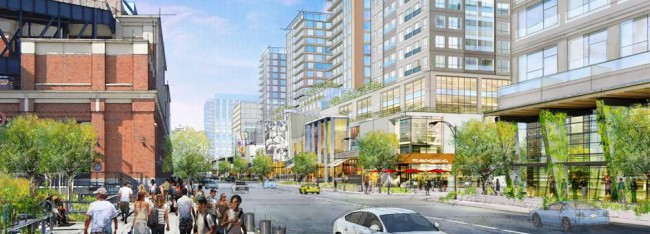
Top: Businesses in Willets Point, Queens; Photo by Max Talbot-Minkin | Bottom: Proposal for redevelopment in Willets Point; Image via New York City Economic Development Corporation (NYCEDC)
Privatizing the Park
A professional baseball stadium, a professional tennis complex, now a soccer arena, all within a single metropolitan park. Imagine the outrage if a developer proposed a single professional sports stadium, let alone three, in Central Park or Prospect Park. At a recent community meeting, City Councilmember Danny Dromm asked rhetorically, “Why don’t they put this in Central Park? Because they always dump on Queens” [10]. The proposal for a third major sports stadium, in conjunction with another stadium expansion and the Willets Point “redevelopment,” is a giant leap forward in the march to privatize – in both form and function – Flushing Meadows.
In form, the park’s current stadiums are heavily corporatized spaces, sponsored by some of the world’s largest financial institutions. The second “i” in Citi Field is a constant reminder to Queens residents that our park is, in part, owned by the biggest bank in the world. The Tennis Center’s major event of the year, the US Open, is sponsored by another financial titan, JP Morgan Chase, and during summer months the park is donned in blue and white Chase advertisements.
In function, the park will be used increasingly as a staging ground for private events, with crowds rushing in and out of the park’s remaining open spaces only to get to their ticketed venue. Ever higher stadium walls restrict access to the events for non-ticket holders. One of the joys of a summer ride on the 7 train used to be catching a glimpse of a game at Shea Stadium as the train pulled into Flushing Meadows. The new Citi Field turns its back on the outside world; it remains to be seen whether SHoP’s design for the MLS stadium would do the same.
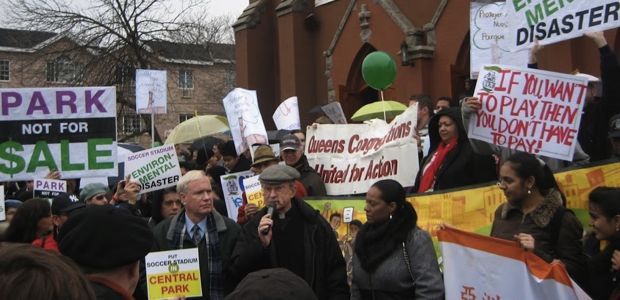
Rally protesting the MLS stadium plan, Queens, December 9, 2012 | Image via Asian Americans for Equality (AAFE)
The message to my neighbors and me is that we must make way for the park’s “best and highest use.” State Senator Jose Peralta told a local newspaper that “a privately financed soccer stadium to replace a big hole in the ground filled with dirty water is a good deal for soccer fans and the park-goers who would get to enjoy the many upgrades to the park.” At a MLS-sponsored “town hall meeting” at Queens Theatre in the Park, featuring free empanadas, Latin music, and Univision celebrities, MLS sold its development as pro-immigrant, pro-athlete, and pro-Queens. A soccer commissioner who grew up in Queens told the largely Latino crowd, “you represent the community that we hope will embrace the beautiful game here in our hometown…. This sport represents the diverse culture in our country, and nowhere is that diverse culture represented more so than in the borough of Queens” [11]. Opponents of the stadium were quietly funneled to the theater’s basement.
A week later, about 100 Queens residents marched through Flushing Meadows in the December rain, decrying the plan. Protesters held signs, many in Spanish, saying “Our Park Is Not For Sale!” and “No Land Grabs!” One soccer player, Luis Gonzalez, told Queens’ Times Ledger, “Our community loves soccer. But that doesn’t mean we want a soccer stadium right in the middle of the park. The kids in our community desperately need open space to exercise… Where are our kids supposed to play?”
We are told by planners that an industrial strip without sidewalks or sewer lines will be transformed into a megamall, taking with it a chunk of park land. The Tennis Center, already covering a large portion of the park, must be expanded to bring in more ticket holders (and their cars). What is now one of the City’s most actively used soccer grounds should become our newest sports venue, to be used just 5.6% of the year. This mode of planning and development amounts to what geographer David Harvey calls “accumulation by dispossession” [12]. Rather than extracting profit from labor, or deriving dividends from investments, this more basic form of development relies simply on taking things — like foreclosures on underwater mortgages, or eminent domain for private projects.
An MLS stadium on top of Flushing Meadow’s soccer fields is neither the best nor highest use for Queens residents. It represents the further devolution of urban planning into the hands of private developers, who sell us back our own culture at prices beyond our reach.

New Stadiums in New York City, Left to Right: Icahn Stadium (Randall’s Island, Track and Field), Yankee Stadium (Bronx, Baseball), Citi Field (Queens, Baseball), Barclays Center (Brooklyn, Basketball and Hockey) | Images via Ross Perlin, Tacos por Vida, David Berkowitz, Lucas Richarz
Stadium Fatigue
New Yorkers are tired of sports stadium developments, but we are also tired of fighting sports stadium developments [13]. Over the past decade, starting with the 2012 NYC Olympics bid and continuing with Icahn Stadium on Randall’s Island, Yankee Stadium in the Bronx, Citi Field in Queens, and the Barclays Center in Brooklyn, stadium after stadium has been proposed for every corner of the city.
In spite of this fatigue, Queens residents are doing their best to bring attention to this most recent sports development. Make the Road New York, Queens Congregations United, and the Fairness Coalition of Queens are organizing in the surrounding neighborhoods, distributing flyers, holding community meetings, and staging protests to challenge MLS’ plan. We can look at the other recently built stadiums as examples of what might come, and we can look to the community-led opposition movements for lessons to be learned. Develop Don’t Destroy and the Atlantic Yards saga show both that community opposition can grow to become city-wide, and also that community benefit agreements can be less than safe bets. Without legal mechanisms for enforcement, there is little to guarantee that the promised number of affordable apartments or union jobs will be created [14]. Bronx residents’ struggles with Yankee Stadium over a new park outside the stadium show that if a stadium is built, persistent pressure must be kept on the developers to provide the promised perks. Finally, the city’s Olympic skepticism and the West Side’s uncompromising opposition show that even the most grandiose stadium development plans can be defeated.
Manhattan residents and politicians have already defeated a similar proposal from Major League Soccer. Though the laws governing the two parks differ, the primary argument against the plans is the same: it’s just not good public policy to replace active ballfields with professional sports stadiums. Nor is it a tribute to working class immigrants to assume they don’t know the difference between playing soccer themselves and paying to watch others perform. It is time to put this plan to rest, and reject the idea that the best way to serve these soccer players is to displace them.
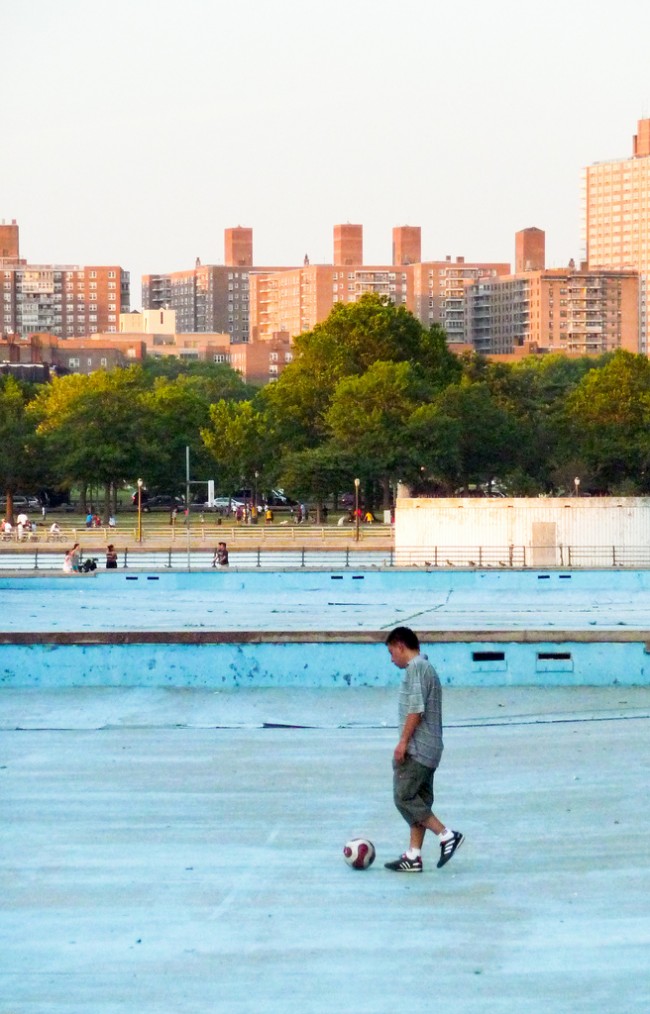
Image via Patternlicious
NOTES:
[1] Queens Soccer Stadium Plans, WNYC
[2] Berman, Marshall. 1982. All That Is Solid Melts Into Air: The Experience of Modernity. New York: Penguin Books, p. 308.
[3] Caro, Robert A. 1974. The Power Broker: Robert Moses and the Fall of New York. New York: Knopf, p. 1113.
[4] O’Malley demanded that Moses build the team a new stadium over Atlantic Yards, the current site of the Barclays Center, but Moses was set on the idea of the Dodgers relocating to Queens. For the full story, see this 1957 article in Sports Illustrated, and the archived documents available at walteromalley.com.
[5] Legal Questions Emerge About Citi Field Mall, City Limits
[6] Bronx activists warn Queens to be wary of soccer stadium deal, Daily News
[7] The bill, known as S928, has been referred to the Senate Cultural Affairs, Tourism, Parks and Recreation committee.
[8] Pro soccer is making a pitch for stadium on park’s Pier 40, The Villager
[9] The planned Willets Point development would extend into the site where Shea Stadium used to stand. Though currently used as a parking lot, it is public park land. Residents Rail Against Flushing Meadows Park Development Plans, DNA.info, New York
[10] Major League Soccer wont get a Queens stadium without a fight, Capital New York
[11] At a carefully coordinated ‘town hall,’ M.L.S. pitches a Queens stadium to a ‘new America’, Capital New York
[12] Harvey, David. 2005. A Brief History of Neoliberalism. New York: Oxford University Press, p. 154.
[13] See, for example, articles in The Village Voice, Curbed NY, and The Village Voice.
[14] Ratner Goes ‘Modular’ in Brooklyn, The Wall Street Journal; Skip the Entertainment, Groups Want Jobs and Housing from Atlantic Yards, Metrofocus/WNET
The views expressed here are those of the authors only and do not reflect the position of The Architectural League of New York.

Comments